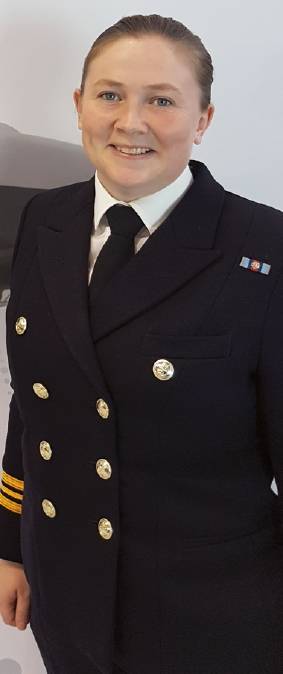Society News
Name: Laura Blagden MRAeS, 31
 Location: Portsmouth, UK.
Location: Portsmouth, UK.
Job title: Maritime Aviation Sustainment Programme Manager.
What inspired you into aviation? From an early age my grandfather would tell exciting stories from his time as an RAF Spitfire pilot, most of them resulting in near-death experiences. I’m glad to say the safety record and understanding of risk to life has vastly improved since his time in the forces but his tales sparked an interest in aviation that ultimately led me to select aerospace engineering at university.
What is the best thing about your current role? My current role is a programme which is all about re-investing savings to make naval aviation more operationally effective and resilient by making best use of current and emerging technologies. It covers a wide variety of areas, including technology, equipment, training, supply and infrastructure. This means that I get to engage daily with ways of making how we do our business better and I find this fascinating. Small technological improvements, for example, introducing digital air traffic control towers or intruding virtual reality to our training, not only have the potential to make savings but also improve the lived experience of service personnel now.
What made you join the Royal Aeronautical Society? The reason I joined the Royal Aeronautical Society was to join a community of similarly interested professionals. I have really enjoyed the available lectures and events – perhaps more during recent times as I can fit them in virtually around a busy day job and catch up later online if they are missed. Having now attained CEng I would like to focus more on mentoring others to attain professional registration.
What three items would you take with you to the space station?
- My current to-read list – I can add books faster than I can read. Maybe a break from Amazon will allow me to catch up.
- Knitting needles (and wool).
- A good supply of caffeine – not sure an engineer can survive without it.
What’s your favourite aircraft? Having worked in the DE&S delivery team in my last role, I would say the F-35 Lightning, as it is our most technically advanced military aircraft that will continue to play a crucial role in our defence for years to come. The way in which it links in all the data to provide the pilot with enhanced situational awareness through the mission systems really is impressive, even if it did make learning the technical elements more challenging.
Who is your biggest inspiration? Rather than just have one, I think I have been really fortunate to meet and work with some amazing people who I admire for different reasons – whether that is their technical knowledge, attention to detail, management skills or dedication to subordinate development – and I always to try to emulate those desirable attributes the best I can.
Piece of advice for someone looking to enter your field? You have to be ready for a range of challenges, broaden your horizons and be ready to develop a whole range of other skills. I’ve had both technically challenging roles on helicopters and the F-35 but I have also worked as an advisor to the Iraqi Army, overcoming language and cultural barriers, managed large numbers of engineers on deployments around the world and instructed at Royal Navy Air Engineer and Survival Equipment School. No job has ever been the same but, if you’re flexible and comfortable with change, then this sort of career can be really rewarding.